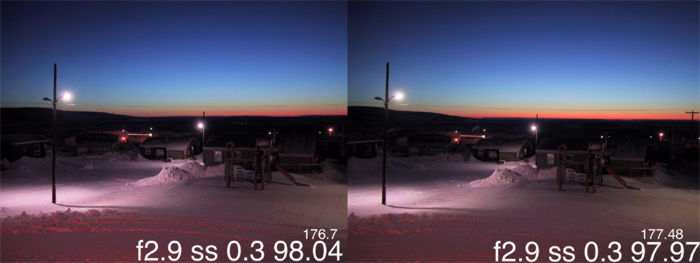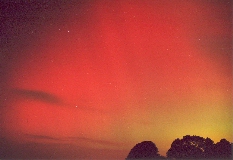|
In het onderstaande artikel van 'The Independent on-line' van 19 december 2004 wordt gesproken over een 'strange lightness at noon' in de Noordelijkse delen van Canada. De verklaring die aan dit verschijnsel wordt gegeven wordt gekoppeld aan de globale opwarming. Door een combinatie van hetere lucht en koudere lucht zou een dergelijk verschijnsel optreden.
Inmiddels heb ik enkele foto's van het verschijnsel kunnen traceren. Op een pagina van de onderzoeker Wayne Davidson (bewoner van Resolute Bay, Nunavut, Canada) zijn deze foto's terug te vinden:

Onder de foto staat het volgende commentaar:
Bright twilight examples in Resolute Bay, with sun at 8 degrees below the horizon. The picture to the right is significantly brighter, despite nearly same sun positions. The difference is explained by the mirages, more extensive and higher in the right picture compared to the left. This means greater trapping of light as well. (bron)
Terwijl de zon op nagenoeg dezelfde hoogte aan de horizon staat is de schemering op het rechterplaatje uitgebreider en hoger. Ik weet niet in hoeverre je kunt spreken van noorderlicht of meer van uitgebreide schemering, maar dit verschijnsel van meer licht lijkt me geen verband te houden met de zonne-verklaring waarover in de basispagina van deze onderzoeksvraag wordt gesproken. We zouden dan kunnen stellen dat er 'noorderlicht-achtige' verschijnselen kunnen optreden die niets te maken hebben met zonne-uitbarstingen. Om echt overtuigend van noorderlicht te kunnen spreken dient er toch meer licht in de lucht waarneembaar te zijn. Wie weet echter hoe dit verschijnsel zich in de toekomst zou kunnen uitbreiden.
Binnen het ascentiekader wordt gesteld dat de Aarde steeds meer zou opwarmen, en dat er meer en meer licht zou komen afkomstig van gebieden onder de grond. Dit zou wellicht een verschijnsel kunnen zijn dat past binnen dit kader. Om zoiets aannemelijker te maken dienen er geen andere steekhoudende verklaringen te zijn, zoals de hier genoemde theorie van de 'thermale inversie', oftewel het weerkaatsen van zonlicht op de warmere luchtlagen die op koudere luchtlagen hangen. Davidson zelf stelt dat er nog geen wetenschappelijke bewijzen zijn voor zijn 'thermale inversie'-theorie, omdat er nog geen database is van 'schemering-dikten' en de dikte van de warme-luchtlagen. We zullen zien hoe het zich ontwikkelt.
In een tekst op de pagina van Wayne Davidson wordt gesproken over deze zonlichtspiegelingstheorie. Dit fragment is ook gecopieerd naar deze pagina, en is terug te vinden onder het artikel van 'The Independent'.
In het eerste artikel hieronder wordt in de laatste paragraaf de suggestie gewekt dat er een verband bestaat tussen de uitstoot van broeikasgassen en de opwarming van de aarde. Binnen onderzoeksvraag 7
en de daaraan gekoppelde broeikassectie worden argumenten aangedragen die dit populaire verband in twijfel trekken.
In een andere pagina op deze site wordt gesproken over het verschijnsel 'aardeschijn', waarmee wordt verwezen naar het licht dat van de Aarde zelf zou afkomen, zoals je het ook kunt hebben over manenschijn en zonneschijn. Er zou sprake zijn van een toename aan aardeschijn. Wellicht levert het op deze huidige pagina genoemde verschijnsel ook wel een bijdrage aan deze aardeschijntoename.
In Januari 2005 is de een-en-dertigste onderzoeksvraag gelanceerd welke zich richt op de mogelijkheid dat de aardas steeds rechter zou gaan staan. In dat kader wordt ook gebruik gemaakt van informatie afkomstig van de heer Davidson.
Arctic lights blamed on climate change
By Geoffrey Lean, Environment Editor
19 December 2004
Santa and his reindeer will be able to see their way better than ever on Christmas Eve, for a mysterious light is beginning to brighten the dark polar winter.
Eskimos and scientists report a strange "lightness at noon" that is turning the usual all-day darkness of the high Canadian Arctic into twilight, apparently in defiance of natural laws. Canadian government officials say it may be the result of an unusual atmospheric phenomenon caused by global warming.
Inuit hunters are telling the government's weather station at Resolute Bay - Canada's second most northerly village, 1,000 miles from the North Pole - of a new light in the sky.
And Wayne Davidson, the Canadian government official who runs the station, says he believes it it caused by climate change.
For the past five years, Mr Davidson says, there has been a growing light along the horizon in the middle of the day in winter. "The entire horizon is raised like magic, like the hand of God is bringing it up," he says.
But Mr Davidson's investigations, backed by other scientists, suggest a more prosaic explanation. Warmer air, from global warming, is overlaying the cold air of the Arctic and the interface between the two creates a kind of "mirror in the sky" which reflects the sun's rays from further south.
So this Christmas Santa may be able to ignore Rudolph's red-nose and rely on pollution from the world's chimneys to find his way down them.
Bron: Arctic lights blamed on climate change (december 2004)
About Seeing Global Warming
Y-V Ulluq Q is an effect, visually recognizable, by distant topographic mirages and by an unusual brightness during twilight. The more distant the mirage the more wide spread the layered air masses above. In the high Arctic, this effect can be dramatic during the long night, an extended period of time when there is no sun at all.
It has been proposed that Canadian Inuit are "seeing" Global Warming. It is quite likely that this theory is correct. But before it is accepted as fact, some rigorous checking must be done. Nevertheless, most cases of Arctic brightness occurred almost always with warm air above.
Inuit hunters eyes should be quite sensitive to yearly fluctuations of twilight. During the long night , they depend on it when hunting, either for recognizing distant land features and or just plain seeing. There is no question about this brightness as well, because the sun was seen several dozens of times, way later than any Navigation tables would permit.
There was the matter of cold air, itself sufficient to increase twilight brightness significantly. It was expected to be the Global Warming indicator, I was monitoring the horizon while waiting for it to get darker with the warming of our Polar atmosphere, but extensive warmer air seems to be mostly aloft. Even if cold surface air has warmed somewhat (3 to 5 C), it is still quite persistently cold near the ground, simply because there is no warm sun at all during the long night. But this cold air brightness had its limits with respect to Inuit memory. Past decades of cold air carried forward light in darkness not as much as with present day thermal inversions. While past thermal inversions were also present, it was very likely that they were not as massive and wide ranging..
Dismissing thermal inversions as the cause for this stronger light, leaves us with massive surface cold air as the primary reason causing this brightness. This for sure is not happening. We know that Arctic surface air is significantly warmer. This leaves us with thermal inversions as the primary, and only cause of this recent increase in brightness.
The work left is to show a correlation between brightness and thermal inversions. This can be done at any meteorological database having in its records Polar Atmospheric profiles, along with spectrometric data, possibly, or indirectly monitoring the twilight. For the mean time , only human eyes have confirmed unusual brightness, human science will have to do the rest.
(bron)
Zie ook:
Op 21 december is er nog een mailtje verzonden naar de onderzoeker Wayne Davidson.
| 
